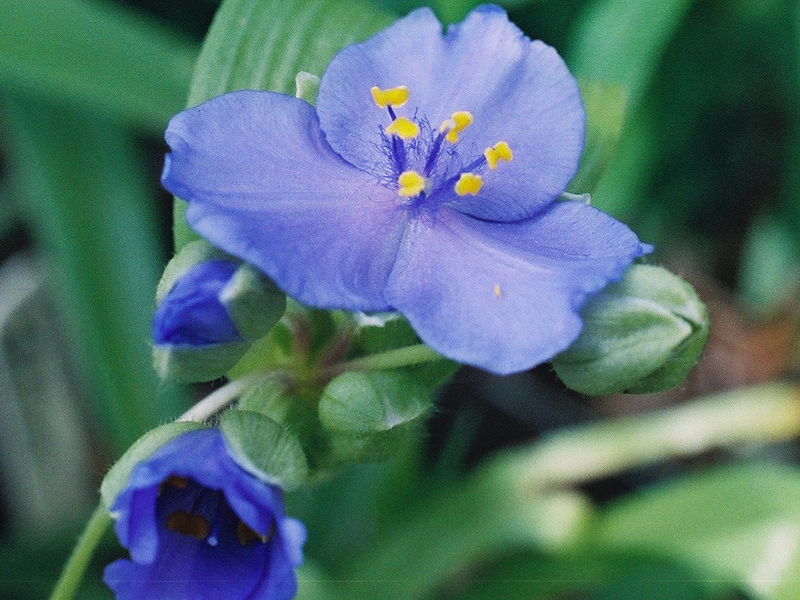Virginia Spiderwort
Tradescantia virginiana
Click here to download a PDF of this plant information page (for printing).

Sun Exposure: Full Sun, Pt Sun, Shade
Season of Interest: Spring, Summer
Bloom Time: May - August
Bloom Color: Blue
Height: 10 to 16 in.
Spread: 16 in.
Spacing: 20 in.
Water Needs: Average
Maintenance: Very little
Soil Type: Clay, Loam, Sandy, Rocky
Soil pH: Acidic
Soil Drainage: Well drained
Pests: Slugs
Diseases: None
Wildlife: Bees, Butterflies

Description:
Virginia spiderwort is a clump-forming, herbaceous perennial which grows up to two feet tall. Blue flowers open up for only one day and bloom in succession from late spring into summer. These blooms arise from grass-like foliage, which adds interesting texture in the garden. Under the right conditions, minimal care is necessary when growing Virginia spiderwort. Though it’s fairly tolerant of a range of conditions, the plant thrives in areas with moist, humus-rich soil. While spiderwort plants enjoy sun, it performs best in partial shade. Add this wildflower to a native woodland, shade garden or naturalized area of the landscape. As it is self-seeding, Virginia spiderwort may need to be kept under control with frequent division in other garden areas. Deadheading spent blooms can help encourage additional flowering and may also aid in limiting its seed dispersal. This plant is great for attracting bees and butterflies to the garden too. For more information see:
plants.ces.ncsu.edu/plants/tradescantia-virginiana
Care and Growing Tips:
Spiderwort is not overly picky about available sunlight. While the plant prefers partial shade, it does well in almost any environment, as long as it gets a few hours of light per day and enough water if exposed to all-day sunlight. Depending on how much sunlight your spiderwort gets, you will notice a difference in the amount and frequency of blooms, so choose a sunnier spot if you want a showy plant. Spiderwort is easily grown in almost any soil condition, as long as it is moist but well-draining. Because the plant clumps and sprawls as it grows, plant it in the spring 4 to 6 inches deep in the soil with about a foot or more between each plant for ample room. While spiderwort is a drought-tolerant plant, it does best in moist soil that's watered every few days, especially during the hotter summer months. However, frequent summer storms will provide enough rain to keep your spiderwort plants happy. It is not fussy when it comes to its temperature and humidity conditions. It has adapted to a range of hardiness zones and temperatures, allowing it to thrive from early spring to late summer.
A single application in early spring at the beginning of its growing period is usually sufficient for outdoor spiderwort plants. Follow the product label instructions for the amount to use. Add compost to the soil for additional nutrients throughout the summer. Spiderwort can look ragged after its bloom period is over. Shearing the plant back by one-third (leaving around 8- to 12-inch stems) or de-leafing to new growth will reinvigorate the plant, increase late-season blooms, and make it look more presentable. Shearing the plant in mid-season also prevents spiderwort from self-sowing and becoming weedy. When shearing, you'll notice secretions that harden to look like spider webs, which is how the plant got its common name.